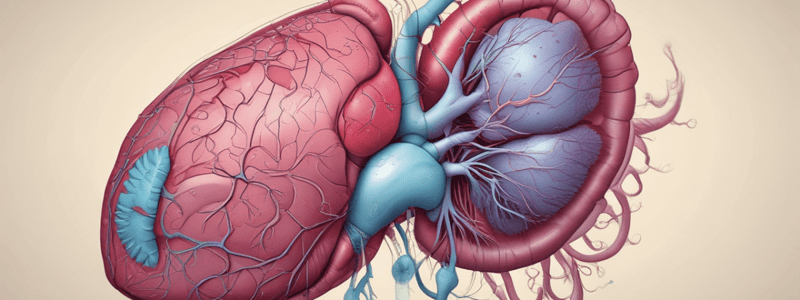Podcast
Questions and Answers
What is a notable ability of the liver regarding transplantation?
What is a notable ability of the liver regarding transplantation?
- It cannot function without the gallbladder.
- A small piece can grow into a larger organ after transplantation. (correct)
- It can regenerate fully after complete removal.
- It is the only organ that does not require oxygen.
Which metabolic processes are primarily carried out by the liver?
Which metabolic processes are primarily carried out by the liver?
- Respiration and filtration.
- Excretion and synthesis.
- Catabolism and anabolism. (correct)
- Digestion and absorption.
In which form can carbohydrates be stored in the liver?
In which form can carbohydrates be stored in the liver?
- As amino acids.
- As glucose only.
- As bile.
- As glycogen. (correct)
Lipoproteins consist of which two types of macromolecules?
Lipoproteins consist of which two types of macromolecules?
Which of the following is NOT a way the liver stores nutrients?
Which of the following is NOT a way the liver stores nutrients?
Which type of molecule primarily builds up in the process of anabolism in the liver?
Which type of molecule primarily builds up in the process of anabolism in the liver?
What is the primary role of the liver in nutrient metabolism?
What is the primary role of the liver in nutrient metabolism?
Triglycerides are commonly associated with which type of storage in the liver?
Triglycerides are commonly associated with which type of storage in the liver?
What is the primary function of cytochrome P450 enzymes in the liver?
What is the primary function of cytochrome P450 enzymes in the liver?
What substance is primarily produced from the processing of proteins in the liver?
What substance is primarily produced from the processing of proteins in the liver?
What effect do cytochrome P450 enzymes have on drug efficacy?
What effect do cytochrome P450 enzymes have on drug efficacy?
Which of the following statements regarding the liver's blood supply is correct?
Which of the following statements regarding the liver's blood supply is correct?
What is the role of the proper hepatic artery?
What is the role of the proper hepatic artery?
How does the liver handle toxins received from the blood?
How does the liver handle toxins received from the blood?
Why is bile production significant for the liver's function?
Why is bile production significant for the liver's function?
What happens to medications when cytochrome P450 enzymes identify them as toxins?
What happens to medications when cytochrome P450 enzymes identify them as toxins?
Which vessel is responsible for carrying blood away from the liver?
Which vessel is responsible for carrying blood away from the liver?
What is primarily affected when the liver detoxifies drugs?
What is primarily affected when the liver detoxifies drugs?
Flashcards are hidden until you start studying
Study Notes
Liver Functions and Characteristics
- The liver is a unique organ capable of regeneration; a small piece can be transplanted and grow into a functional liver.
- Key functions include metabolism (catabolism and anabolism), nutrient storage, detoxification, and bile production.
Metabolism
- Catabolism: Breakdown of nutrients for energy.
- Anabolism: Synthesis of larger macromolecules from smaller units.
- Responsible for the processing of carbohydrates (as glycogen) and fats (as lipoproteins and triglycerides).
Nutrient Storage
- Carbohydrates: Stored as glycogen, a polysaccharide of simple sugars.
- Fats: Stored mainly as triglycerides and as lipoproteins (fatty protein complexes).
- Proteins are processed (e.g., into albumin) but not stored; they enter the bloodstream for various functions.
Detoxification
- The liver detoxifies harmful substances using cytochrome P450 enzymes, which can interact with various substrates.
- Medications can be detoxified, leading to decreased drug efficacy; specific dosing is necessary to account for this process.
Bile Production
- Bile is crucial for fat absorption and produced by the liver for digestive functions.
Blood Supply
- The liver has two distinct blood supplies:
- Portal Vein: Brings nutrient-rich blood from the intestinal tract.
- Proper Hepatic Artery: Supplies oxygen-rich blood.
Blood Outflow
- Blood exits the liver through the Hepatic Vein, which is nutrient- and oxygen-poor.
- Blood cycles back to the heart for oxygenation, then returns to the liver via the portal vein or hepatic artery.
Bile Transport
- Bile leaves the liver primarily through the Common Hepatic Duct, essential for fat digestion.
Studying That Suits You
Use AI to generate personalized quizzes and flashcards to suit your learning preferences.





